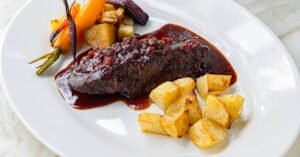As pet owners, we’re always curious about what human foods we can safely share with our furry friends. One common question that pops up is, “Can dogs eat rice?” It’s a staple in many households, and you might wonder if it’s a good addition to your dog’s diet. In this text, we’ll dive deep into the nutritional aspects, benefits, potential risks, and best practices for feeding rice to dogs. Drawing from veterinary insights and nutritional science, we’ll help you make informed decisions to keep your pup healthy and happy. Whether you’re dealing with a picky eater or looking for bland diet options during tummy troubles, understanding if and how dogs can eat rice is essential. Stick with us as we break it all down.
Key Takeaways
- Dogs can safely eat rice as a source of easily digestible carbohydrates and some vitamins, but it should supplement a balanced diet rather than replace it.
- White rice is ideal for dogs with upset stomachs due to its easy digestibility, while brown rice offers more nutrients for long-term health.
- Feeding rice to dogs provides benefits like soothing gastrointestinal issues, aiding weight management, and adding variety to meals for picky eaters.
- Avoid potential risks by serving plain, cooked rice in moderation to prevent obesity, digestive upset, or rare allergic reactions.
- Prepare rice for dogs by rinsing and boiling it without seasonings, and limit portions to no more than 10% of their daily intake.
- Consult a veterinarian before introducing rice, especially for dogs with allergies, diabetes, or persistent digestive problems.
Nutritional Value of Rice for Dogs
Rice is a grain that’s been a dietary staple for humans for centuries, but what about our canine companions? When we consider the nutritional value of rice for dogs, it’s important to look at its composition. Primarily, rice is a source of carbohydrates, providing energy through easily digestible starches. It contains small amounts of protein, though not as much as meat or other animal-based foods.You can learn more about how-long-can-a-dog-go-without-water
In terms of vitamins and minerals, rice offers B vitamins like thiamine and niacin, which support energy metabolism and nervous system health. It also has traces of iron, magnesium, and manganese. But, rice isn’t a complete food for dogs: it lacks essential amino acids and fats that dogs need for a balanced diet. We often recommend it as a supplement rather than a primary ingredient.
From an SEO perspective, if you’re searching for “can dogs eat rice,” know that plain, cooked rice can be a gentle carb source, especially for dogs with sensitive stomachs. But remember, the nutritional punch varies by type, white rice is more processed and less nutrient-dense than brown rice. We’ll explore that more later. Overall, rice can contribute to your dog’s nutrition when used thoughtfully, helping with calorie intake without overwhelming their system.You can learn more about how-much-zyrtec-can-i-give-my-dog
Benefits of Feeding Rice to Dogs
Feeding rice to dogs comes with several benefits that we’ve seen in our experience with pet nutrition. First off, it’s an excellent option for dogs recovering from gastrointestinal issues. Veterinarians often suggest a bland diet of rice and boiled chicken to soothe upset stomachs, as rice is easy to digest and can help firm up loose stools.You can learn more about how-much-bendryl-can-a-dog-have
Another perk is its role in weight management. For overweight dogs, rice can provide filling bulk without excessive calories, especially when mixed with veggies or lean proteins. It’s also hypoallergenic for many dogs, making it a safe choice for those with food sensitivities to common allergens like wheat or corn.
We appreciate how rice can add variety to a dog’s meal. If your pup is a finicky eater, incorporating a bit of cooked rice might encourage them to finish their food. Plus, for active dogs, the carbs in rice offer a quick energy boost. Studies from sources like the American Kennel Club support that moderate rice inclusion supports overall digestive health. Just ensure it’s part of a balanced diet, rice alone won’t cut it, but as an addition, it shines.You can learn more about how-long-can-dogs-go-without-food
Potential Risks and Side Effects
While rice can be beneficial, we’re upfront about the potential risks and side effects of feeding it to dogs. Not every dog will react the same way, and overdoing it could lead to problems. For instance, excessive rice might contribute to obesity if it’s high in calories without balancing exercise.
Digestive Issues
One common concern is digestive upset. If rice isn’t cooked properly or if your dog eats too much at once, it could cause bloating, gas, or constipation. Brown rice, with its higher fiber content, might exacerbate diarrhea in sensitive pups if introduced suddenly. We advise starting small to monitor how your dog handles it.You can learn more about how-much-does-it-cost-to-spay-a-dog
Allergies and Sensitivities
Though rare, some dogs may have allergies to rice, showing symptoms like itchy skin, ear infections, or vomiting. If your dog has a history of grain sensitivities, rice might not be ideal. Always watch for signs of adverse reactions, and consult a vet if you notice anything off. In our view, these risks are minimal with moderation, but awareness is key when asking, “can dogs eat rice?”
Types of Rice Safe for Dogs
Not all rice is created equal when it comes to our dogs’ diets. We believe in choosing the right type to maximize benefits and minimize risks. Generally, plain, cooked rice without seasonings is safe, but let’s break down the varieties.
White Rice vs. Brown Rice
White rice is refined, with the hull removed, making it easier to digest and a go-to for upset tummies. It’s lower in fiber, which is great for dogs with diarrhea. Brown rice, on the other hand, retains its bran layer, offering more fiber, vitamins, and minerals like selenium. It’s better for long-term nutrition but can be harder on the gut if your dog isn’t used to it. We often recommend white for short-term use and brown for added nutrients in healthy dogs.
Other Varieties
Beyond basics, basmati or jasmine rice can be fine if plain and cooked. Avoid wild rice, which is actually a grass seed and might be too fibrous. Instant or flavored rices are a no-go due to additives like salt or onions, which are toxic to dogs. Stick to simple options to ensure safety when feeding rice.
How to Prepare and Serve Rice to Dogs
Preparing rice for dogs is straightforward, but we emphasize doing it right to avoid issues. Start with rinsing the rice to remove excess starch, then cook it in plain water, no butter, salt, or spices. Boiling until soft ensures it’s digestible.
Serve it mixed with your dog’s regular food or as part of a bland meal. For example, combine it with boiled lean meat for a soothing diet. We suggest cooling it to room temperature to prevent burns.
Portion Sizes and Frequency
Portion sizes depend on your dog’s size and needs. For a small dog, 1-2 tablespoons per meal: for larger breeds, up to a cup. Frequency-wise, rice shouldn’t exceed 10% of their daily intake to maintain balance. Feed it occasionally or as needed for health issues, not daily, to prevent nutritional gaps. Always adjust based on your vet’s advice.
When to Consult a Veterinarian
Even with something as simple as rice, there are times when we strongly recommend consulting a veterinarian. If your dog shows persistent digestive problems like vomiting or diarrhea after eating rice, it could signal an underlying issue. Puppies, seniors, or dogs with conditions like diabetes might need tailored advice, as rice’s carbs could affect blood sugar.
We also advise a vet check if you’re introducing rice to a dog with known allergies or if you’re unsure about portions. In emergencies, like if your dog ingests seasoned rice with harmful ingredients, seek immediate help. Regular check-ups ensure that adding rice fits into your dog’s overall health plan. Remember, while we share general knowledge, professional input is invaluable.
Conclusion
In wrapping up, we’ve explored the ins and outs of whether dogs can eat rice, from its nutritional value to preparation tips. It’s clear that rice can be a safe, beneficial addition to your dog’s diet when used wisely, offering digestive relief and energy without major downsides for most pups. But, moderation and monitoring are key to avoiding risks. We encourage you to experiment thoughtfully and always prioritize your dog’s unique needs. If in doubt, chat with your vet. By incorporating rice appropriately, you’re taking a step toward better pet nutrition. Thanks for reading, here’s to happy, healthy dogs.how-much-does-it-cost-to-put-a-dog-down
Frequently Asked Questions
Can dogs eat rice safely?
Yes, dogs can eat rice safely when it’s plain and cooked. It’s a good source of carbohydrates for energy and can help with digestive issues like upset stomachs. However, it should be given in moderation as part of a balanced diet, not as the main food, to avoid nutritional deficiencies.
What are the benefits of feeding rice to dogs?
Feeding rice to dogs offers benefits like aiding digestion during gastrointestinal troubles, providing quick energy for active pups, and helping with weight management by adding bulk without excess calories. It’s also hypoallergenic for many dogs and can encourage picky eaters to finish meals, according to veterinary insights.
Are there any risks when dogs eat rice?
While generally safe, risks include digestive issues like bloating or constipation if overfed or not cooked properly. Some dogs may have rare allergies, showing symptoms like itching or vomiting. Excessive rice can lead to obesity, so monitor portions and consult a vet for dogs with sensitivities.
What types of rice are best for dogs?
White rice is ideal for dogs with sensitive stomachs due to its easy digestibility and low fiber. Brown rice provides more nutrients like fiber and vitamins but may be harder to digest. Stick to plain, cooked varieties like basmati; avoid flavored or instant rice with additives harmful to dogs.
How much rice can I feed my dog daily?
Portion sizes vary by dog size: 1-2 tablespoons for small dogs and up to a cup for larger breeds, not exceeding 10% of daily intake. Feed occasionally, not daily, to maintain nutritional balance. For dogs with conditions like diabetes, limit carbs as they can affect blood sugar—consult a vet for personalized advice.
Can dogs eat rice if they have allergies to grains?
Rice is often hypoallergenic compared to grains like wheat or corn, but some dogs may still be sensitive. If your dog has grain allergies, test small amounts and watch for reactions like skin irritation. Alternatives include grain-free options like sweet potatoes; always seek veterinary guidance for allergy management.

















